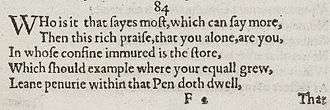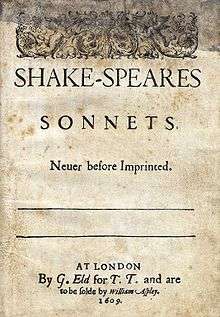Sonnet 84
Sonnet 84 is one of 154 sonnets published by the English playwright and poet William Shakespeare in 1609. It's part of the Fair Youth sequence, and the seventh sonnet of the Rival Poet group.
| Sonnet 84 | |||||||
|---|---|---|---|---|---|---|---|
 The first five lines of Sonnet 84 in the 1609 Quarto | |||||||
| |||||||
Exegesis
This poem extends the debate of the Rival Poet group of sonnets: Is the young man praised best in the simple, true and straightforward manner of the speaker, or in the more rhetorically flamboyant style of other poets? The first quatrain asks: Which of the poets can say more to the young man than “You are uniquely you? Inside of you is stored all that can offer the example (or simile) worthy (or equal) of you?” The suggestion is that there is no simile worthy, and without a simile or metaphor there will be no poetry. The second quatrain says that it is an impoverished pen that cannot write something to add some glory to his subject, but in the youth's case all that writer needs to do is simply describe the youth. Just copy, don't make it worse, and the writer will become famous for his wit. The couplet points out that the desire the youth has for flattery hurts the praise he receives, because that praise is not the simple, and ideal description — it is mere flattery. This is an idea that sounds like the problem Cordelia has in King Lear: Whatever she can say about her father, he wants flattery, and she cannot satisfy that desire.[2][3]
Structure
Sonnet 84 is an English or Shakespearean sonnet, which has three quatrains, followed by a final rhyming couplet. It follows the rhyme scheme ABAB CDCD EFEF GG and is composed in iambic pentameter, a metre of five feet per line, with two syllables in each foot accented weak/strong. Most of the lines are examples of regular iambic pentameter, including the 11th line:
× / × / × / × / × / And such a counterpart shall fame his wit Line 12 has a variation in the first foot – a reversal of the accent: / × × / × / × / × / Making his style admired every where. (84.11-12)
- / = ictus, a metrically strong syllabic position. × = nonictus.
The meter calls for a few variant pronunciations: line 3's "confine" may be stressed on the second syllable (even though a noun) and "immurèd" needs to be pronounced with 3 syllables;[4] while line 13's "beauteous" is pronounced with only 2 syllables and line 14's "being" only 1.[5]
Notes
- Shakespeare, William. Duncan-Jones, Katherine. Shakespeare’s Sonnets. Bloomsbury Arden 2010. p. 279 ISBN 9781408017975.
- Shakespeare, William. Duncan-Jones, Katherine. Shakespeare’s Sonnets. Bloomsbury Arden 2010. p. 278 ISBN 9781408017975.
- Booth, Stephen, ed. Shakespeare's Sonnets (Rev. ed.). New Haven: Yale Nota Bene. (2000) p. 283
- Booth 2000, p. 72.
- Booth 2000, p. 285.
References
- First edition and facsimile
- Shakespeare, William (1609). Shake-speares Sonnets: Never Before Imprinted. London: Thomas Thorpe.CS1 maint: ref=harv (link)
- Lee, Sidney, ed. (1905). Shakespeares Sonnets: Being a reproduction in facsimile of the first edition. Oxford: Clarendon Press. OCLC 458829162.
- Variorum editions
- Alden, Raymond Macdonald, ed. (1916). The Sonnets of Shakespeare. Boston: Houghton Mifflin Company. OCLC 234756.
- Rollins, Hyder Edward, ed. (1944). A New Variorum Edition of Shakespeare: The Sonnets [2 Volumes]. Philadelphia: J. B. Lippincott & Co. OCLC 6028485.
- Modern critical editions
- Atkins, Carl D., ed. (2007). Shakespeare's Sonnets: With Three Hundred Years of Commentary. Madison: Fairleigh Dickinson University Press. ISBN 978-0-8386-4163-7. OCLC 86090499.
- Booth, Stephen, ed. (2000) [1st ed. 1977]. Shakespeare's Sonnets (Rev. ed.). New Haven: Yale Nota Bene. ISBN 0-300-01959-9. OCLC 2968040.
- Burrow, Colin, ed. (2002). The Complete Sonnets and Poems. The Oxford Shakespeare. Oxford: Oxford University Press. ISBN 978-0192819338. OCLC 48532938.
- Duncan-Jones, Katherine, ed. (2010) [1st ed. 1997]. Shakespeare's Sonnets. The Arden Shakespeare, Third Series (Rev. ed.). London: Bloomsbury. ISBN 978-1-4080-1797-5. OCLC 755065951.
- Evans, G. Blakemore, ed. (1996). The Sonnets. The New Cambridge Shakespeare. Cambridge: Cambridge University Press. ISBN 978-0521294034. OCLC 32272082.
- Kerrigan, John, ed. (1995) [1st ed. 1986]. The Sonnets ; and, A Lover's Complaint. New Penguin Shakespeare (Rev. ed.). Penguin Books. ISBN 0-14-070732-8. OCLC 15018446.
- Mowat, Barbara A.; Werstine, Paul, eds. (2006). Shakespeare's Sonnets & Poems. Folger Shakespeare Library. New York: Washington Square Press. ISBN 978-0743273282. OCLC 64594469.
- Orgel, Stephen, ed. (2001). The Sonnets. The Pelican Shakespeare (Rev. ed.). New York: Penguin Books. ISBN 978-0140714531. OCLC 46683809.
- Vendler, Helen, ed. (1997). The Art of Shakespeare's Sonnets. Cambridge, MA: The Belknap Press of Harvard University Press. ISBN 0-674-63712-7. OCLC 36806589.
.png)
